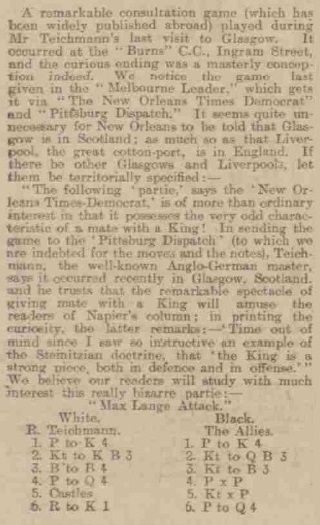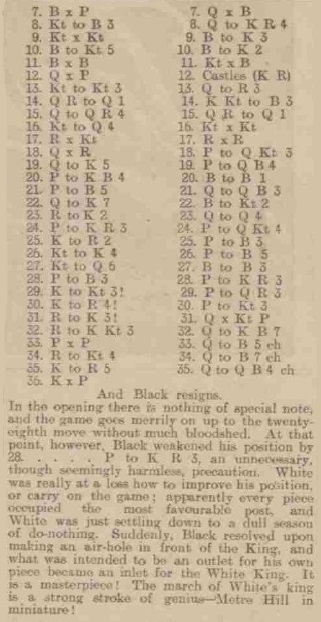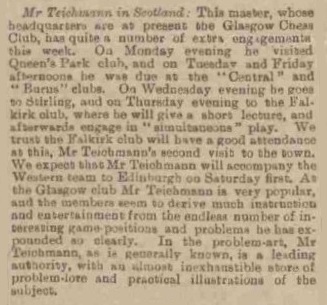Chess Notes
Edward Winter
When contacting us by e-mail, correspondents are asked to include their name and full postal address and, when providing information, to quote exact book and magazine sources. The word ‘chess’ needs to appear in the subject-line or in the message itself.
| First column | << previous | Archives [165] | next >> | Current column |
10785. Howard Staunton and the Earl of Carlisle
John Townsend (Wokingham, England) writes:
‘Regarding Staunton’s paternity, a novel variation on the Earl of Carlisle story was discussed briefly in an Australian newspaper. This was the Cairns Post of 11 July 1934, which carried on page 8 the following remarks under the heading “New Books”, as part of the London – Week by Week column, “From Our Special Correspondent”:
“In his book A Century of British Chess, newly published, Mr Philip Sergeant repeats the assertion that Howard Staunton, ‘the father of British chess’, was treated ungenerously by his father, the fifth Lord Carlisle.
Actually Staunton was enabled to devote himself to serious chess through Lord Carlisle’s generosity. He was the son of a housemaid at Castle Howard. His mother continued to live for many years in the neighbouring village of Coneysthorpe.”’
10786. Helms brilliancies

American Chess Bulletin, March-April 1940, page 50
From a tribute to Hermann Helms by Fred Reinfeld on page 9 of the January 1950 Chess Review:

The first game is discussed in the feature article A Brilliancy by Hermann Helms.
Concerning Helms v Tenner, there are discrepancies over the exact occasion. The game was published as follows on page 42 of the March-April 1942 issue of Helms’ American Chess Bulletin:
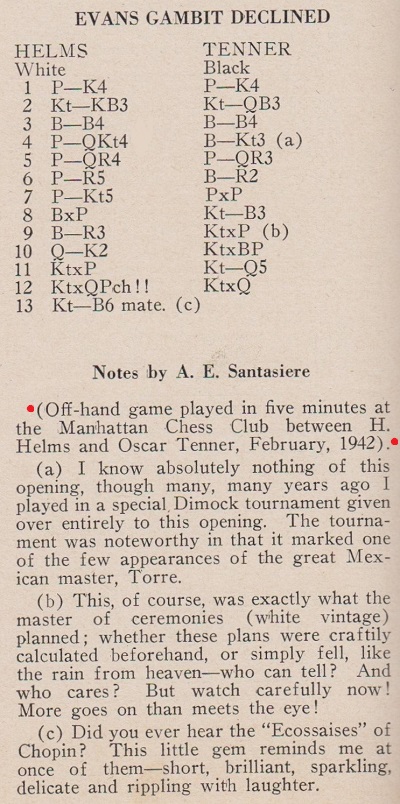
1 e4 e5 2 Nf3 Nc6 3 Bc4 Bc5 4 b4 Bb6 5 a4 a6 6 a5 Ba7 7 b5 axb5 8 Bxb5 Nf6 9 Ba3 Nxe4 10 Qe2 Nxf2 11 Nxe5 Nd4 12 Nxd7+ Nxe2 13 Nf6 mate.
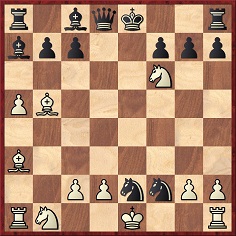
Another source (page 8 of the New York Post, 14 February 1942) gave different information:
‘Hermann Helms, dean of the American chess press, brought off a pretty queen sacrifice in a rapid-transit game at the Marshall lightning tourney. The victim, the veteran Oscar Tenner, succumbed after only four minutes and ten seconds of play.’
The introduction on page 8 of Section II of the Los Angeles Times, 15 March 1942:
‘The game below, from a recent Marshall tournament, shows Herman[n] Helms mating another veteran, Oscar Tenner, in a quickie that couldn’t have lasted more than four or five minutes.’
It was with the Manhattan, and not Marshall, Chess Club that Tenner was most associated, as stated in his obituary on page 9 of the January-February 1949 American Chess Bulletin:

10787. Helms v Tenner (C.N. 10786)
Eduardo Bauzá Mercére (New York, NY, USA) has found that Helms himself published his brilliancy against Tenner in the New York Sun of 21 February 1942, page 21:

Although most of the column is a report on a lightning tournament at the Marshall Chess Club, there is a change of topic towards the end. Helms does not specify whether his game against Tenner occurred in a rapid-transit competition, as opposed to being an off-hand encounter, but does state that the venue was the Manhattan Chess Club.
10788. American deans
Further to the description of Hermann Helms on page 8 of the New York Post, 14 February 1942 as the ‘dean of the American chess press’ (C.N. 10786), we mention, firstly, a fine, extensive tribute to him (‘the undisputed Dean of American Chess’) by Frank Brady on pages 3-4 of Profile of a Prodigy (various editions). As shown below, however, the word ‘undisputed’ may be disputed.
Helms received the title officially at a testimonial dinner on 20 August 1943. From page 278 of the October 1943 Chess Review:
‘In recognition of his remarkable record and long devotion to the cause of chess, President Sturgis of the USCF conferred on Hermann Helms the official title of Dean of American Chess.’

In the previous decade, versions of the title accorded to Helms were more limited, such as ‘the dean of American chess writers and publishers’ (Morning Call, 29 January 1933, page 10). The Cincinnati Enquirer of 12 November 1933 (page 2, section IV) wrote concerning Helms, ‘we believe he is the dean of American chess editors in experience, service and possibly age’.
Before the ‘official title of Dean of American Chess’ was conferred on Helms, similar titles had been given to others. Page 11 (Sports section) of the 25 August 1922 New York Times called Jackson Whipps Showalter the ‘dean of American chess players’. After publishing a letter from Walter Penn Shipley about Albert Beauregard Hodges, page 169 of the October 1941 Chess Review had an editorial note which began: ‘Rival candidate to the title of Dean of American Chess, octogenarian Shipley is a few years [sic] older than Hodges ...’ On page 168 of Capablanca’s Best Chess Endings (Oxford, 1978) Irving Chernev called Shipley ‘The Dean of American Chess for several generations’.
Page 67 of the March 1943 Chess Review referred to Frank James Marshall as the ‘Dean of American Chess’. Marshall, incidentally, was a speaker at the dinner at which the title was bestowed upon Helms (American Chess Bulletin, September-October 1943, page 73).
Showalter died in 1935, Shipley in 1942, and Hodges and Marshall in 1944. Following Marshall’s death, the 11 November 1944 edition of the Los Angeles Times (page 4, part I) called him the ‘dean of American chess masters’, and page 32 of the Brooklyn Daily Eagle, 12 November 1944 had the ‘dean of American chess players’:
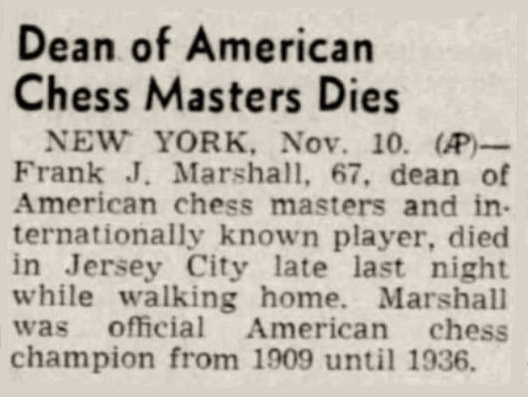
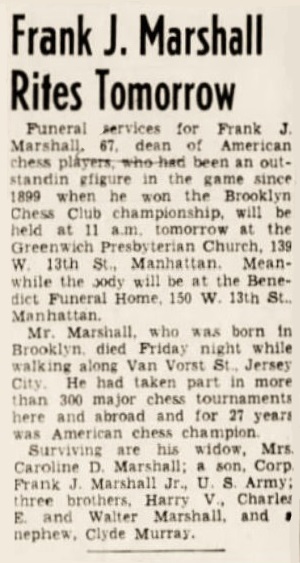
Reuben Fine was incorrect when he wrote on page 190 of The World’s Great Chess Games (New York, 1976) that Marshall ‘remained the dean of American chess until his death in 1943’.
On page 5 of the January 1946 Chess Review Fine applied the term ‘the dean of American chess masters’ to Edward Lasker. A brief tournament report on page 4 of the August 1947 Chess Review called Lasker ‘Dean of American Masters’ and Helms ‘Dean of American Chess’.
‘Dean of American Chessmasters’ was the description of Abraham Kupchik on the front cover of the May 1949 Chess Review:
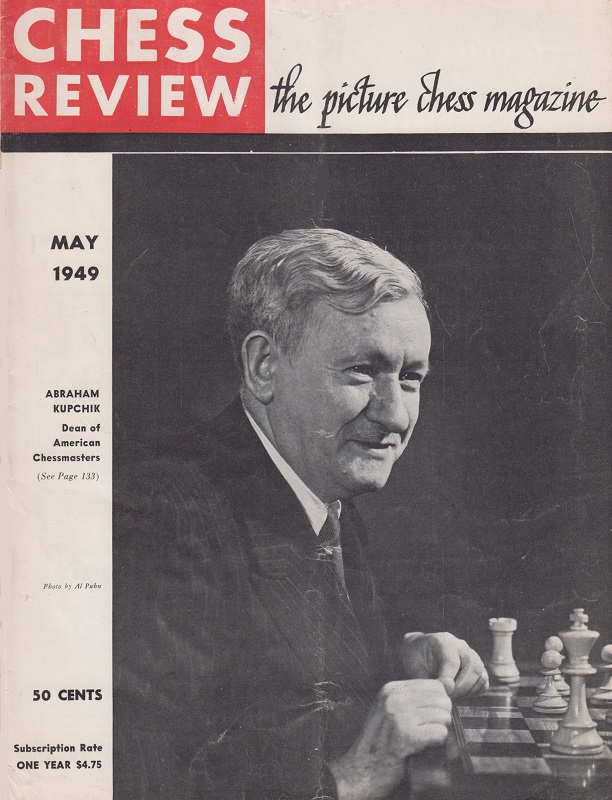
The corresponding article on page 133 stated: ‘Oldest and most durable of the masters competing in this series [Metropolitan Chess League matches] is Abraham Kupchik, dean of American chessmasters.’
How much significance or value the ‘dean’ title ever had is another question. As regards the perks, if that word is not too strong, on page 33 of the February 1963 Chess Life John W. Collins referred to Helms as ‘the Dean, an Honorary Member of all clubs in the United States’.
On page 31 of the same issue William Lombardy suggested that Helms, the ‘Dean of American Chess’, was ‘the Chess world’s most loved figure’:
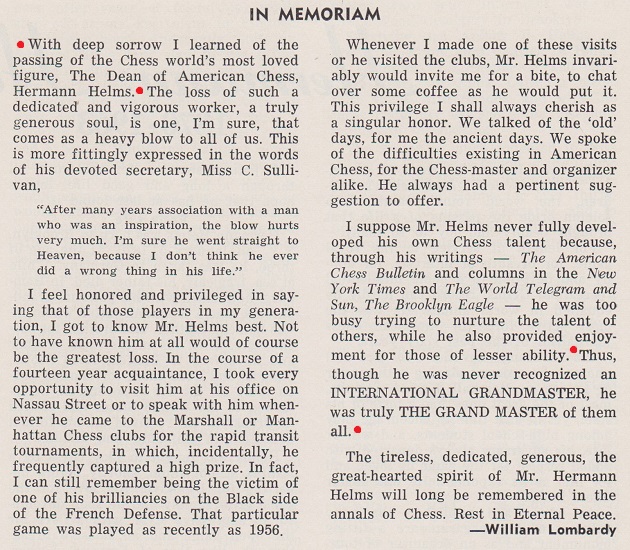
The brief notice of Helms’ death on page 72 of the March 1963 BCM had no geographical restrictions: he was ‘the doyen of all chess journalists’.
10789. The Rice Gambit (C.N.s 6857 & 10781)
Michael Negele (Wuppertal, Germany) considers that the final score of the Rice Gambit match won by Schlechter against Lasker in 1908 is more likely to have been +3 –0 =2 (Deutsche Schachzeitung – C.N. 6857) than +4 –0 =2 (Allgemeine Sport-Zeitung – C.N. 10781). He provides a cutting from page 104 of the 15 June 1908 issue of Süddeutsche Schachblätter, in which Eduard Dyckhoff reported that only five games were to be played:

Our correspondent adds that the venue was originally due to be Ústí nad Labem in Northern Bohemia, but that the match was finally played in Prague, starting in mid-June and lasting ten days (Lasker’s Chess Magazine, September 1908, page 98). In Süddeutsche Schachblätter, 15 July 1908 Dyckhoff stated, without mention of any possible change in the number of games from five to six, that Schlechter won ‘mit +4 bei 2 Remisen’, which would mean, in a five-game match, four points and not four wins:

As shown in C.N. 6857, page 292 of the September 1908 Deutsche Schachzeitung reported:
‘Es wurden zu diesem Zwecke in Prag ... fünf Partien gespielt ... Das Resultat war: Schlechter gewann dreimal, zwei Partien blieben unentschieden.’
10790. A Punch cartoon
From page 241 of CHESS, 25 May 1963:
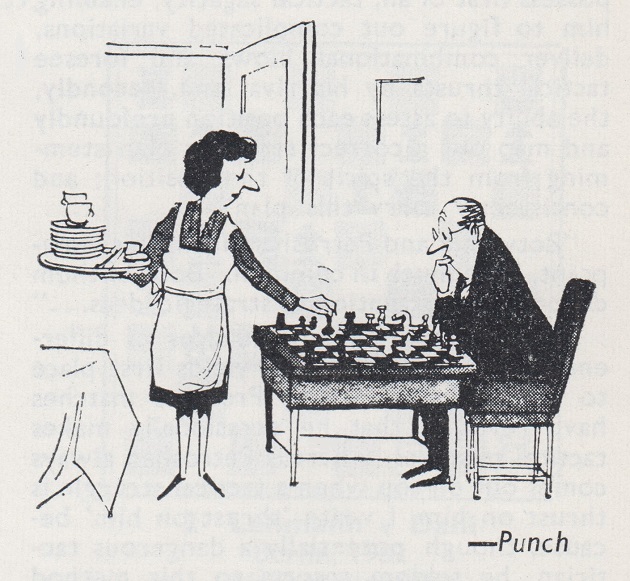
10791. Other deans (C.N. 10788)
- ‘Because he was the dean of the chess world for 30 years Tarrasch’s vices and virtues have been magnified out of all proportion.’ Reuben Fine, on page 12 of Chess Review, March 1944. The same text is on page 62 of Fine’s book The World’s Great Chess Games (New York, 1951).
- ‘... the inimitable dean of modern chess masters, Dr Savielly Tartakower.’ Reuben Fine, on page 169 of Chess Marches On! (New York, 1945).
- ‘... The dean of present-day masters is Jacques Mieses, who is still going strong at 83.’ Reuben Fine, on page 125 of The World’s a Chessboard (Philadelphia, 1948).
10792. Eddie Mair
A reference to chess by the brilliant BBC broadcaster Eddie Mair.
10793. The Sunday Express (C.N.s 10700, 10745 & 10753)
Following up on a reference provided by Alan Smith (Stockport, England), we are able to show David Joseph’s composition as it appeared on page 15 of the Sunday Express, 4 December 1921:

10794. The Daily Express
From a report on the 1962-63 Hastings congress on page 99 of CHESS, 26 January 1963:
‘The Daily Express gave one mention to the congress, reporting that A.T. Watson in making a move, split his trousers.’
The item was on the front page of the Daily Express, 3 January 1963:

10795. Where was Hermann Helms born?
An article entitled ‘Facts about the Publisher’ on pages 152-157 of the July-August 1917 American Chess Bulletin stated:
‘The career of the present publisher of the American Chess Bulletin began on 5 January 1870, when he first saw the light of day in the then city of Brooklyn, NY, which has since become a borough of New York city.’
There are, nonetheless, unauthoritative assertions that Helms was born in Hamburg or Great Britain:
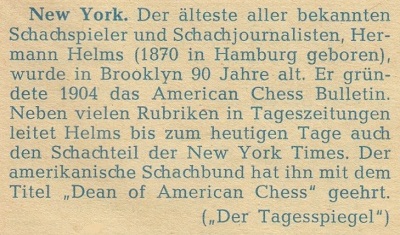
Schach-Echo, 5 February 1960, inside back cover
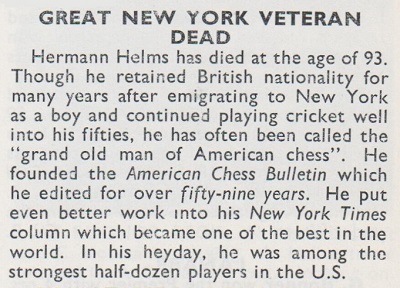
CHESS, 25 May 1963, page 257.
10796. Helms v Roething
A game-score given on page 51 of Chess Life, February 1963 without any venue or date:

1 e4 e5 2 Nf3 Nc6 3 Bb5 Nf6 4 O-O Nxe4 5 d4 Be7 6 Qe2 Nd6 7 Bxc6 dxc6 8 dxe5 Nf5 9 Rd1 Bd7 10 e6 fxe6 11 Ne5 Bd6 12 Qh5+ g6 13 Nxg6 Ng7 14 Qh6 Nf5 15 Qh3 Qf6 16 Nxh8 O-O-O 17 Nc3 Rg8 18 Ne4 Qxh8 19 c4 e5 20 c5
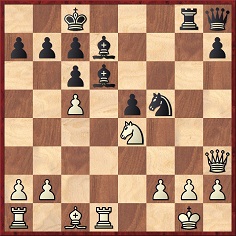
20...Ng3 21 Qxd7+ Kxd7 22 hxg3 Rg6 23 cxd6 cxd6 24 f4 exf4 25 Bxf4 d5 26 Nc5+ Kc8 27 b4 b6 28 Nb3 Qg8 29 Rac1 h5 30 Nd4 Kb7 31 a4 Qf8 32 b5 c5 33 Nf3 d4 34 Re1 Rf6 35 Re5 Rf5 36 Rce1 Rxe5 37 Nxe5 Kc8 38 Nc6 Kd7 39 Nxa7 c4 40 Nc6 d3 41 Re7+ Qxe7 42 Nxe7 Kxe7 43 Bd2 Resigns.
Eduardo Bauzá Mercére (New York, NY, USA) points out that the game was played in the first round of the General Tournament of the New York State Chess Association on 22 February 1894 and was published in the Brooklyn Standard Union the following day.
10797. Otto Roething
Mr Bauzá Mercére provides three cuttings:
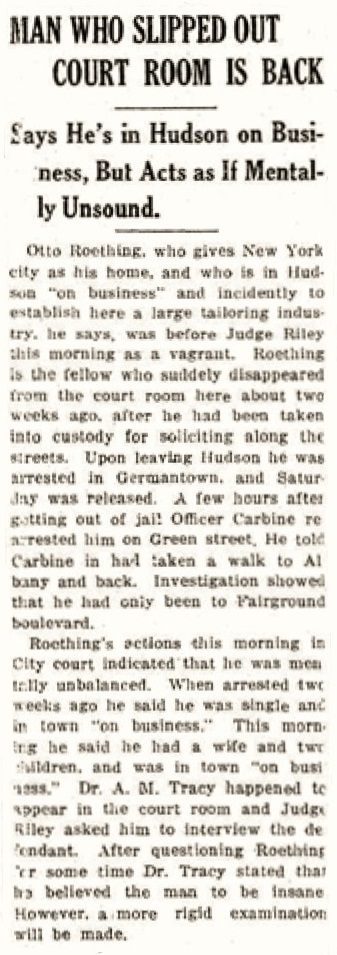
Hudson Evening Register, 27 July 1914, page 5

Hudson Evening Register, 30 July 1914, page 8
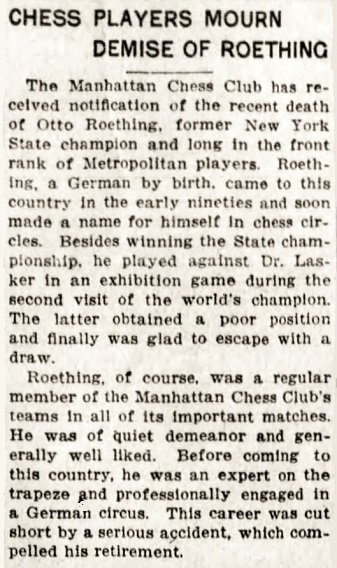
Brooklyn Daily Eagle, 15 August 1915, section five, page 3.
We add a group photograph published by the American Chess Bulletin on page 134 of its December 1904 issue:
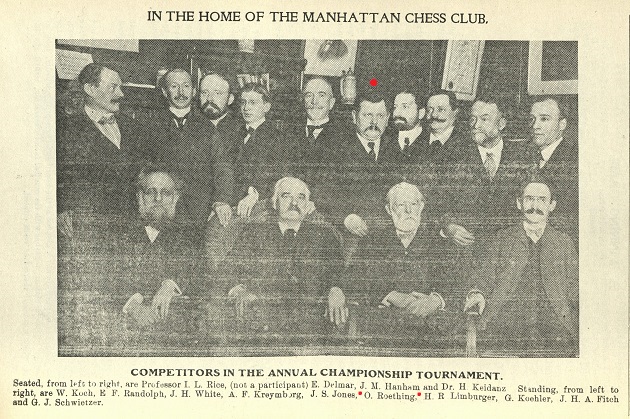
Finally, two photographs from the November 1905 American Chess Bulletin, pages 330 and 337:
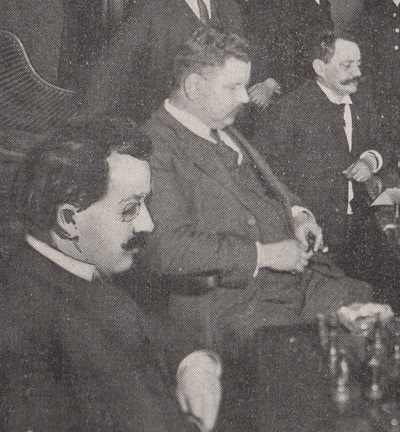
In the library of the Manhattan Chess Club (detail). Left to right: G. Simonson, O. Roething, G.H. Koehler
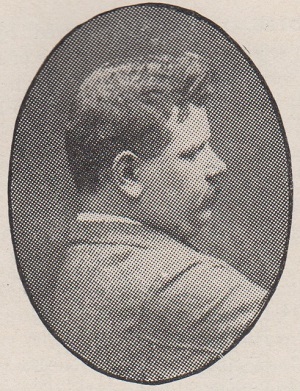
O. Roething
10798. Teichmann’s king march
1 e4 e5 2 Nf3 Nc6 3 Bc4 Nf6 4 d4 exd4 5 O-O Nxe4 6 Re1 d5 7 Bxd5 Qxd5 8 Nc3 Qh5 9 Nxe4 Be6 10 Bg5 Be7 11 Bxe7 Nxe7 12 Qxd4 O-O 13 Ng3 Qh6 14 Rad1 Nc6 15 Qa4 Rad8 16 Nd4 Nxd4 17 Rxd4 Rxd4 18 Qxd4 b6 19 Qe5 c5 20 f4 Bc8 21 f5 Qc6 22 Qe7 Bb7 23 Re2 Qd5 24 h3 b5 25 Kh2 (As will be seen below, there is no unanimity over the move-order in this phase.) 25...f6 26 Ne4 c4 27 Nd6 Bc6 28 c3 h6 29 Kg3 a6 30 Kh4 g6 31 Re3 Qxg2 32 Rg3 Qf2 33 fxg6 Qf4+ 34 Rg4 Qf2+ 35 Kh5 Qc5+ 36 Kxh6 Resigns.
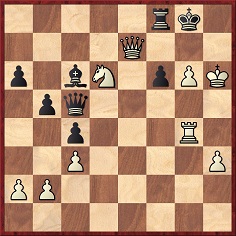
From Alan McGowan (Waterloo, Canada):
‘It appears that the well-known game Teichmann v Allies, supposedly played in Glasgow in 1902, actually occurred there three years later.
The game is in various books and databases, and Teichmann’s use of his king in the closing stages is a winning idea seen in Short v Timman, Tilburg, 1991. There are slightly different versions of the Teichmann game, and, for instance, page 75 of L. Pachman’s Modern Chess Strategy (London, 1963) had 28 Kh2, 29 Kg3 and 30 Kh4, whereas White appears to have placed his king on h2 a few moves earlier:
I have noted this reference to the game on page 8 of the Falkirk Herald, 20 September 1905:
Page 8 of the Falkirk Herald of 15 March 1905 gave the dates of some of Teichmann’s engagements:
Monday, 13 March: Queen’s Park Chess Club
Tuesday, 14 March: Central Chess Club
Wednesday, 15 March: Stirling
Thursday, 16 March: Falkirk Chess Club
Friday, 17 March: Burns Chess Club.The Queen’s Park, Central and Burns Chess Clubs were all in Glasgow.’
We add the game’s appearance on page 11 of section two of the 11 June 1905 New Orleans Times-Democrat:
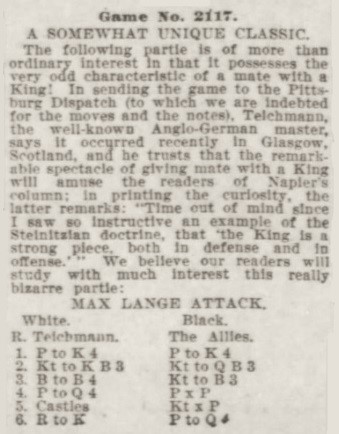

John Hilbert (Amherst, NY, USA) has forwarded us a photocopy of the game’s original publication, by W.E. Napier, in the Pittsburg Dispatch of 5 June 1905.
Teichmann had also visited Glasgow in 1901-02, for four months (BCM, February 1902, page 60), but Napier’s report of the communication from Teichmann indicates that the king-march game was played recently, i.e. in March 1905.
No publication of the game prior to 5 June 1905 has been found, and we wonder when the date 1902 was first proposed. An early instance in a book is the first edition of Edward [Eduard] Lasker’s Schachstrategie (Leipzig, 1911), pages 100-102:

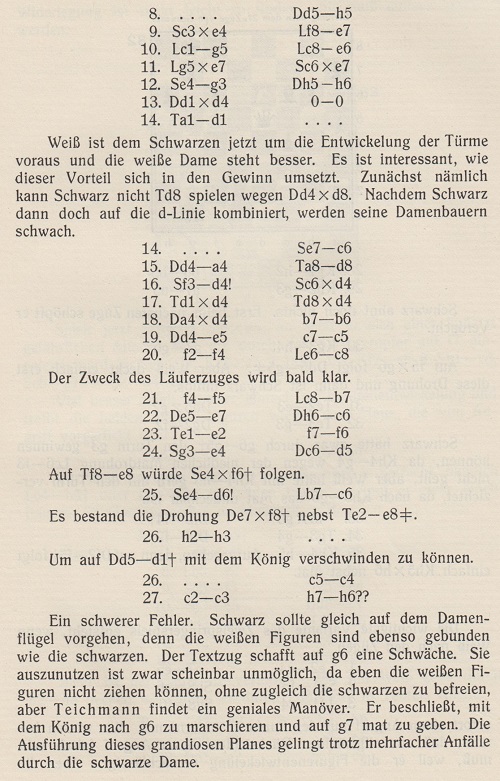
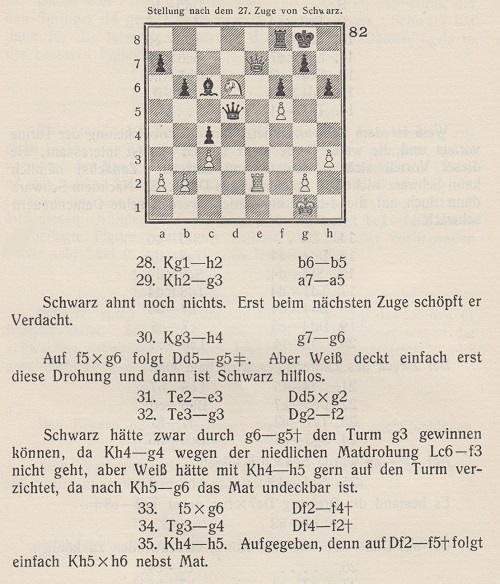
As mentioned in C.N. 7933, Beratende is a German word for consultants/allies. In Lasker’s final note, a move by the black queen to c5 (QB4), and not f5 (KB4), was evidently meant. The move order given by Lasker included the sequence 28 Kh2, 29 Kg3 and 30 Kh4, as in the Pachman book but also, strange to say, as in item 114 of Unit Two of Napier’s Amenities and Background of Chess-Play (New York, 1934), which, moreover, had the date 1902. See too pages 167-168 of Paul Morphy and The Golden Age of Chess by W.E. Napier (New York, 1957 and 1971).
10799. Theta (C.N.s 3780 & 9272)
Two further columns by ‘Theta’, on whom information is still sought:
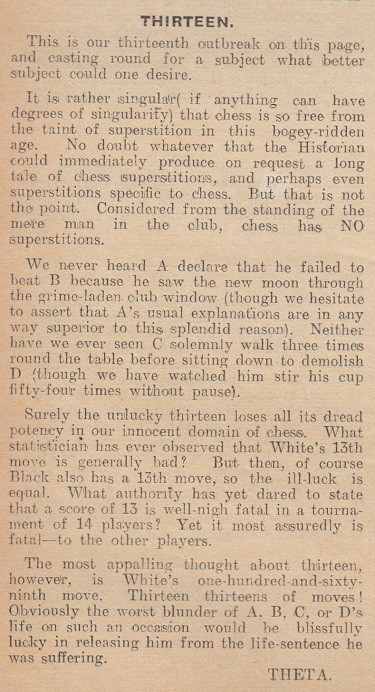
Source: Chess Amateur, October 1926, page 1.

Source: Chess Amateur, July 1928, page 301.
Regarding rumour, gossip and speculation, we have noted before the prevalence of comments along the lines of ‘I think I read somewhere someone reckons Carlson would of beat Fisher’. A milder example from page 197 of the Chess Player’s Chronicle, February 1875:
‘It was stated somewhere or other the other day that Miss Rudge might probably play a match with the Championess of the United States.’
10800. McConnell v Pillsbury
C.N. 7611 showed a photograph from page 2 of the third part of the Daily Times-Picayune (New Orleans) of 9 March 1913. A version of better quality is given now, from page 14 of the New Orleans Times-Democrat, 15 April 1900:
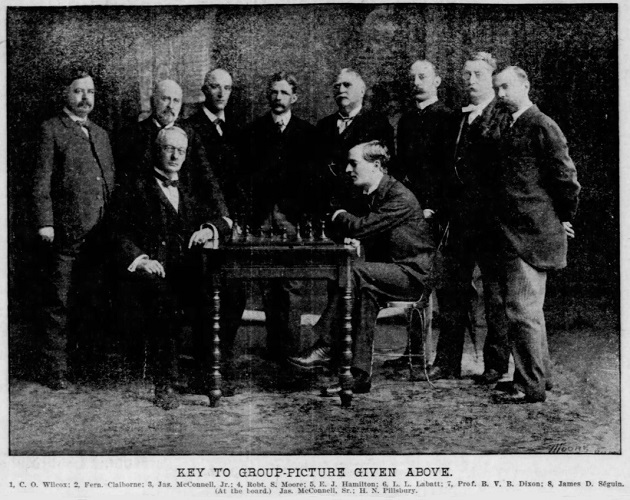
10801. Games by Lord Dunsany and Sir John Simon
Alan Smith (Stockport, England) has forwarded games played by Lord Dunsany and Sir John Simon:
Montague Jones – Lord Dunsany
Living chess, Ramsgate, 30 March 1929
Scotch Game
1 e4 e5 2 Nf3 Nc6 3 d4 exd4 4 Nxd4 Bc5 5 Be3 Nf6 6 Nc3 Bxd4 7 Bxd4 d6 8 Bb5 Bd7 9 O-O O-O 10 f3 Re8 11 Bxc6 Bxc6 12 Ne2 Bb5 13 Bxf6 Qxf6 14 c3 Rad8 15 Nd4 Bxf1 16 Qxf1 c6 17 Rd1 d5 18 exd5 Rxd5 19 h3 Red8 20 Re1 Qg6 21 g4
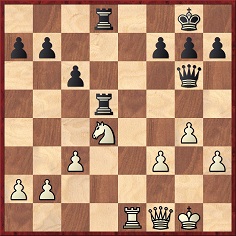
21...f5 22 Kh2 fxg4 23 fxg4 c5 24 Nf5 Kh8 25 Ne7 Rd2+ 26 Kh1 Qd6 27 Nf5 Qh2 mate.
Source: Brooklyn Daily Eagle, 1 August, 1929, page 27:

A report on the event in the Observer, 31 March 1929, page 12:
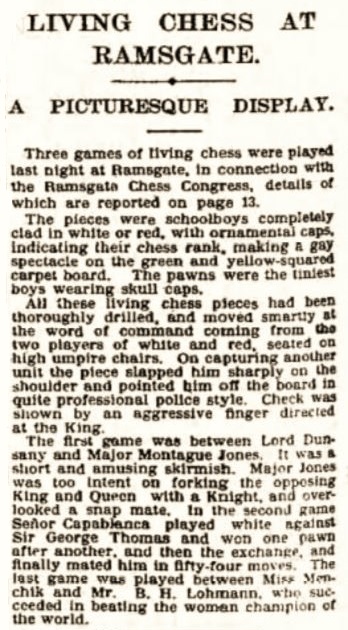
Sir John Simon – G.M. Thomas
Reform Club v Queen’s Club, 1929
Queen’s Gambit Declined
1 d4 d5 2 c4 e6 3 Nc3 Nf6 4 Bg5 Nbd7 5 Nf3 Be7 6 e3 O-O 7 cxd5 exd5 8 Bd3 b6 9 O-O Bb7 10 Rc1 c5 11 Bb1 Rc8 12 Bxf6 Nxf6 13 Ne5 Re8 14 Qc2 Bd6
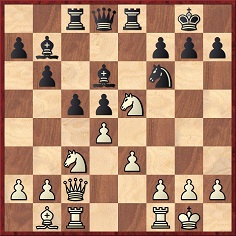
15 Ng4 cxd4 16 exd4 Nxg4 17 Qh7+ Kf8 18 Qh8+ Ke7 19 Rfe1+ Kd7 20 Bf5+ Kc7 21 Nb5+ Kb8 22 Rxc8+ Bxc8 23 Rxe8 Qg5 24 Rxc8+ Kb7 25 Nxd6+ Resigns.
Source: Times Literary Supplement, 28 November 1929, page 1007:
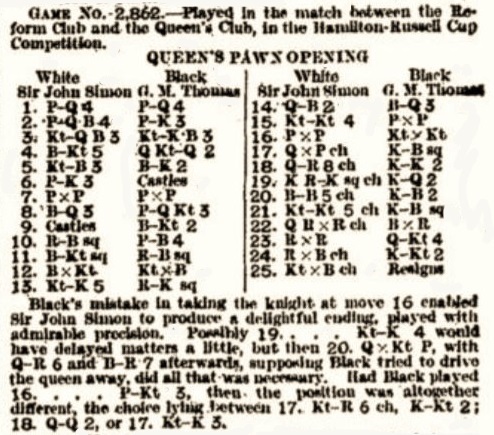
Sir John Simon – Morley Roberts
Reform Club v Authors’ Club, December 1933
Albin Counter-Gambit
1 d4 d5 2 c4 e5 3 dxe5 d4 4 Nf3 Nc6 5 a3 Be6 6 Qc2 Bc5 7 b4 d3 8 exd3 Bd4 9 Bb2 Bxb2 10 Qxb2 Nge7 11 d4 Bg4 12 d5 Nxd5 13 cxd5 Qxd5 14 Nc3 Qe6 15 Nb5 Rc8 16 Be2 Bxf3 17 Bxf3 Nxe5 18 O-O Nxf3+ 19 gxf3 O-O 20 Kh1 Qh3 21 Rg1 Qxf3+ 22 Rg2 g6 23 Nd4 Qd5 24 Re1 c5 25 bxc5 Rxc5 26 f3 Rc4 27 Re4 Rd8 28 Rd2 Qh5
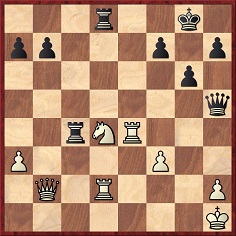
29 Re3 Rdc8 30 Nb3 Qb5 31 Red3 Qe8 32 Re2 Qc6 33 Kg2 Rg4+ 34 Kf2 Rh4 35 Ke1 Qb6 36 Rde3 Rf8 37 Qc3 h6 38 Kf1 Qb5 39 Nd4 Qd5 40 Re4 Rh5 41 Re8 Rxe8 42 Rxe8+ Kh7 and White wins.
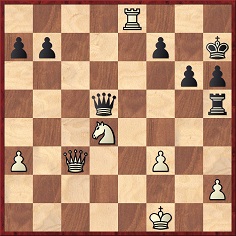
Source: The Times, 11 December 1933, page 18:
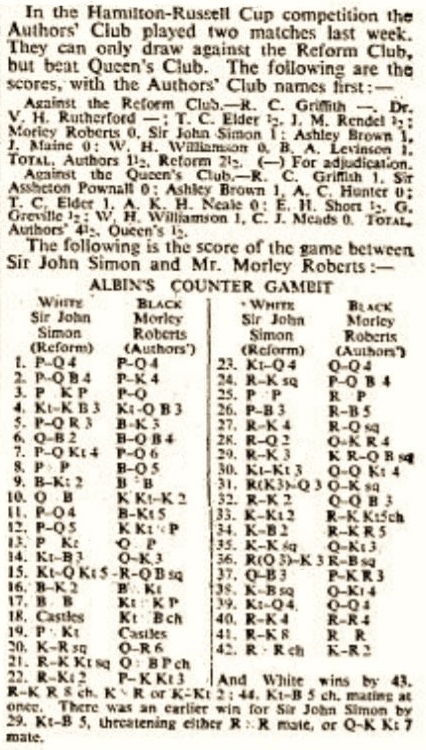
Alan Smith also notes that the game against Fairburn in our feature article on Sir John Simon was played on 19 November 1937, a report being published in The Times, 23 November 1937, page 19.
10802. Quiz question
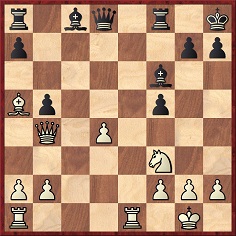
Which move has just been played?
10803. Arthur Koestler
Further to C.N.s 3266 (see page 250 of Chess Facts and Fables), 3509, 3580 and 6511, Mike Salter (Sydney, Australia) notes references to chess in Arthur Koestler’s Scum of the Earth (London, 1941):
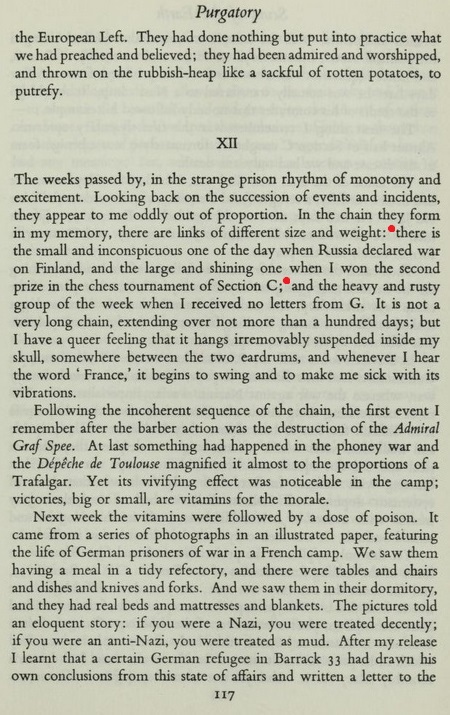

Our correspondent adds, from page 11 of the 1955 edition, a further passage (also to be found on the Kingpin website):
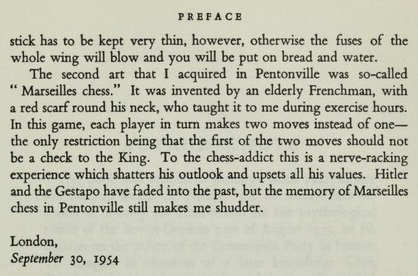
10804. Otto Roething (C.N. 10797)
The entry on Roething in Chess Personalia A Biobibliography by Jeremy Gaige (Jefferson, 1987):
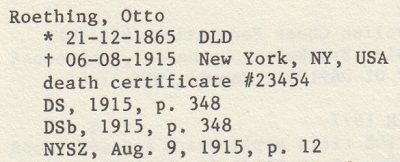
The unpublished 1994 edition had no further information.
Eduardo Bauzá Mercére (New York, NY, USA) provides the above-mentioned item in the New Yorker Staats-Zeitung und Herold:
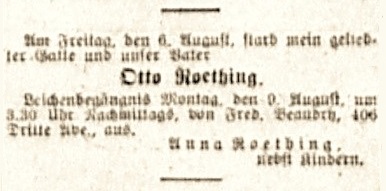
10805. Which move has just been played? (C.N. 10802)

This position arose in a game in Sweden during the First World War, and White has just played 19 Bxa5.
The full score: 1 e4 e5 2 Nf3 Nf6 3 Nxe5 d6 4 Nf3 Nxe4 5 d4 d5 6 Bd3 Be7 7 O-O O-O 8 Re1 f5 9 c4 c6 10 Qb3 Kh8 11 Nc3 dxc4 12 Bxc4 Nd6 13 Bd3 Bf6 14 Bf4 Na6 15 Bxa6 bxa6 16 Qb4 Nb5 17 Nxb5 cxb5
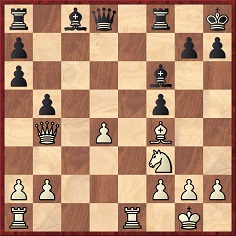
18 Bc7 a5 19 Bxa5 Resigns.
Below are two contemporary appearances of the game, between G. Nyholm and E. Jacobson, on page 101 of the May-July 1915 Tidskrift för Schack and on pages 124-125 of the Schachjahrbuch für 1915/16 by Ludwig Bachmann (Ansbach, 1917):
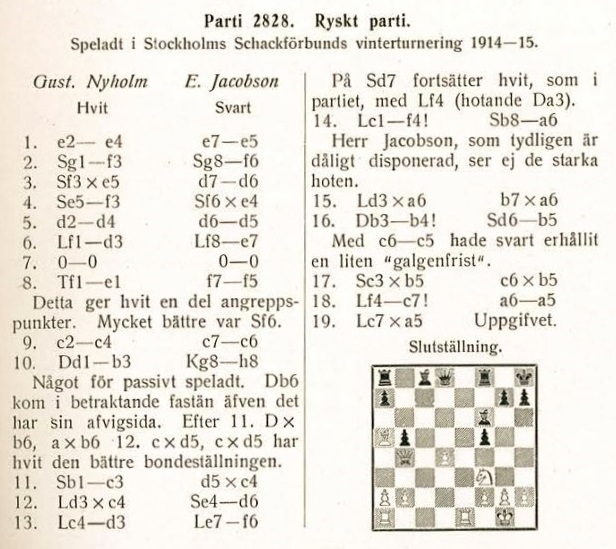
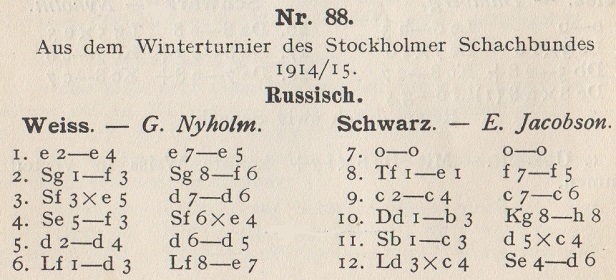
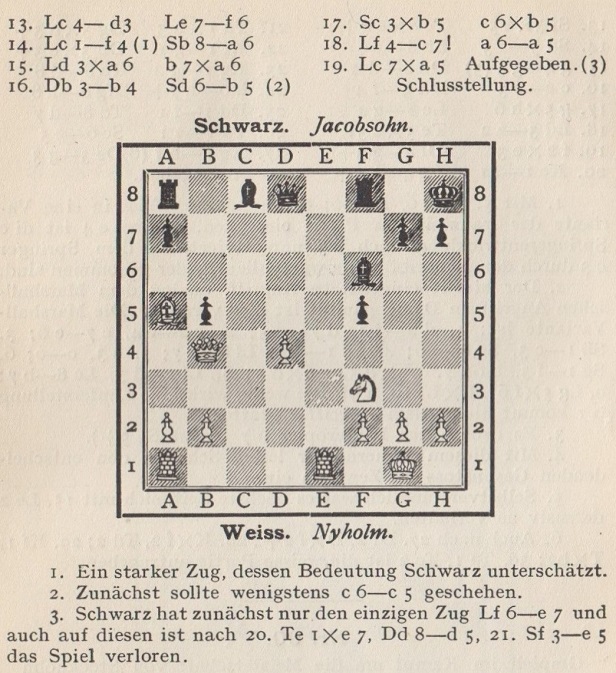
Eduardo Bauzá Mercére (New York, NY, USA) has created a game which reaches the requisite position by a different route: 1 d4 f5 2 c4 Nf6 3 Nc3 e6 4 Nf3 d5 5 e3 Bd6 6 Bd3 O-O 7 O-O c5 8 Re1 cxd4 9 exd4 dxc4 10 Bxc4 Nc6 11 Bxe6+ Kh8 12 Bc4 Na5 13 Qa4 Nxc4 14 Qxc4 Ne4 15 Bd2 Nxc3 16 Bxc3 Be7 17 Qa4 Bf6 18 Ba5 b5 19 Qb4.
10806. Torre v N.N.
Maurice Carter (Fairborn, OH, USA) sends this win by Carlos Torre from the scrapbook published by Dale Brandreth which was discussed in C.N. 2996 (see page 51 of Chess Facts and Fables):
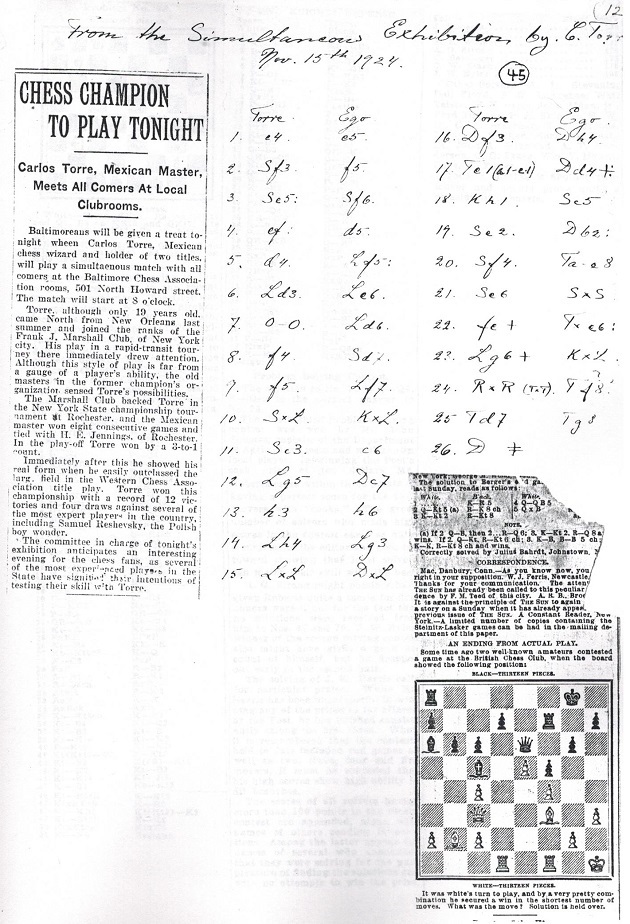
1 e4 e5 2 Nf3 f5 3 Nxe5 Nf6 4 exf5 d5 5 d4 Bxf5 6 Bd3 Be6 7 O-O Bd6 8 f4 Nbd7 9 f5 Bf7 10 Nxf7 Kxf7 11 Nc3 c6 12 Bg5 Qc7 13 h3 h6 14 Bh4 Bg3 15 Bxg3 Qxg3 16 Qf3 Qh4 17 Rae1 Qxd4+ 18 Kh1 Nc5 19 Ne2 Qxb2 20 Nf4 Rae8 21 Ne6 Nxe6 22 fxe6+ Rxe6 23 Bg6+ Kxg6 24 Rxe6 Rf8 25 Re7 Rg8 26 Qf5 mate.
We add that the above announcement about Torre’s display was on page 11 of the Baltimore Sun, 15 November 1924. Two further reports from that newspaper:

Baltimore Sun, 11 November 1924, page 16

Baltimore Sun, 17 November 1924, page 8
As so often, there are statistical discrepancies, and page 217 of the December 1924 American Chess Bulletin misdated the exhibition and had a strange reference to J.C. Moore Jr:

The photograph below is from opposite page 838 of the February 1928 issue of L’Echiquier:
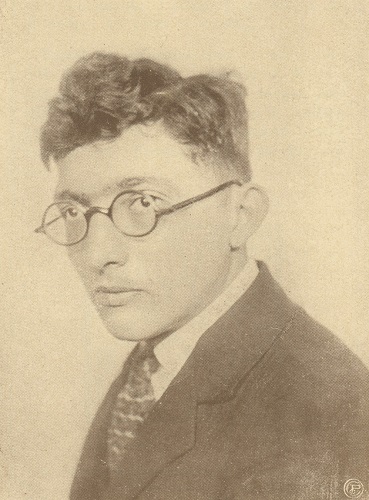
Carlos Torre
10807. Elaine Saunders
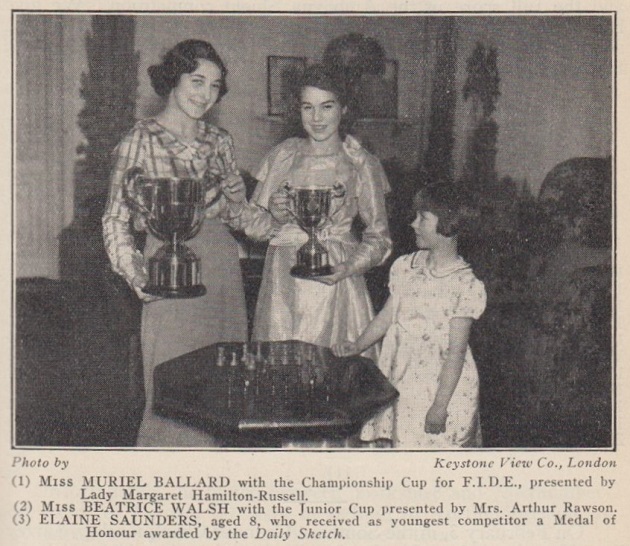
BCM, March 1934, page 109.
10808. Fischer and the big red book (C.N.s 8962, 9167, 10677, 10682 & 10686)
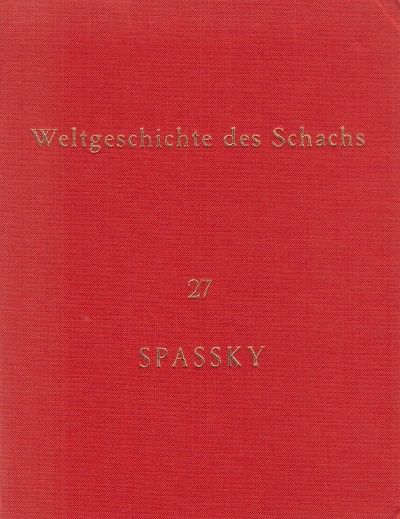
From Sean Robinson (Tacoma, WA, USA):
‘It seems that John Donaldson gives the final word on this subject in his magnificent five-volume overview of Fischer’s career, published in digital form between 2015 and 2017. The third volume, Collected Annotations and Articles by Bobby Fischer (2016), describes the “big red book” and the Wade dossier in detail. Donaldson also unearths buried treasure: handwritten, previously unseen annotations by Fischer in the book and the dossier.
The Donaldson work is in digital form, not yet in print, and my citations reflect cumbersome “locations” in the e-version rather than page numbers.
The key section, labeled “The Wade Files”, begins at location 6188. Donaldson describes a meeting with Kevin O’Connell, who explained how the Wade dossier was compiled to meet Fischer’s demanding deadlines. O’Connell noted that he and Les Blackstock aided in the drafting of note-cards.
The section includes a picture: the binder of Spassky’s 1 d4 games. The image is also viewable at the World Chess Hall of Fame. (Donaldson collaborated on the exhibit.)
The Wade dossier is clearly a green loose-leaf binder. There is no red velvet binding as claimed by Edmonds and Eidinow. Frank Brady’s description of the dossier in Endgame is more accurate, apart from color.
Donaldson also discusses Fischer’s use of the Wildhagen Spassky book (location 6287). Again, he provides an image (see the above Hall of Fame link) and states that Fischer received an advance copy from the publisher in 1971. The subsequent section, featuring Fischer’s unseen notes to Spassky’s games, is irresistible.
Assessment: The Wildhagen volume was the only red book. It has an ordinary library binding, not velvet, and it is the red book that appears in the black and white image from the New York Times. The erroneous “velvet” description starts with that newspaper’s article in 1972. Edmonds and Eidinow added a layer of confusion when they described the Wade dossier as “bound in red velvet”.’
10809. Earlier appearances sought
A feature from the chess column on page 6 of the Hampstead & Highgate Express, 28 July 1894:
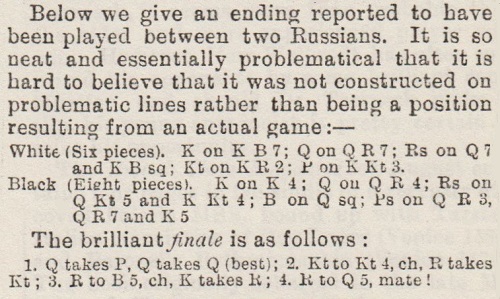

White to move
Wanted: earlier appearances of this position, with or without mention of 1...Rg7+ for Black.
10810. At
the end of the 1927 world championship match
Despite its innocuous title, the editorial below (L’Echiquier, December 1927, pages 783-784) delivers a message which may be summarized as ‘good riddance to Capablanca’:
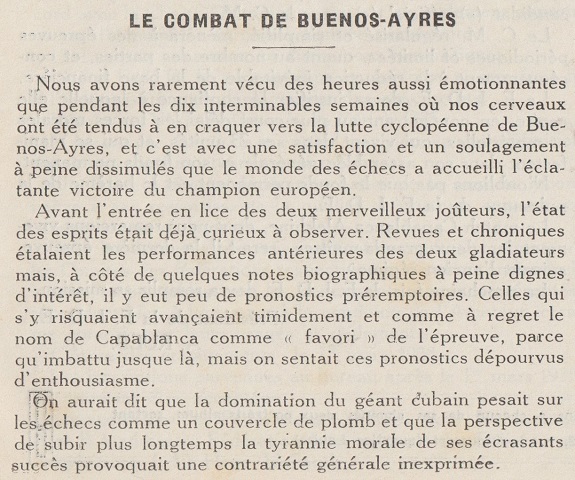
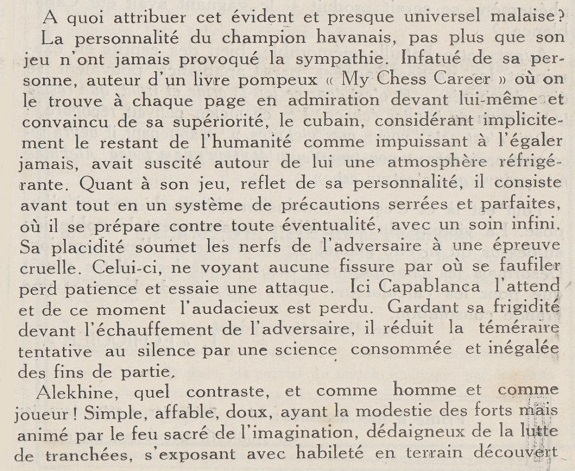
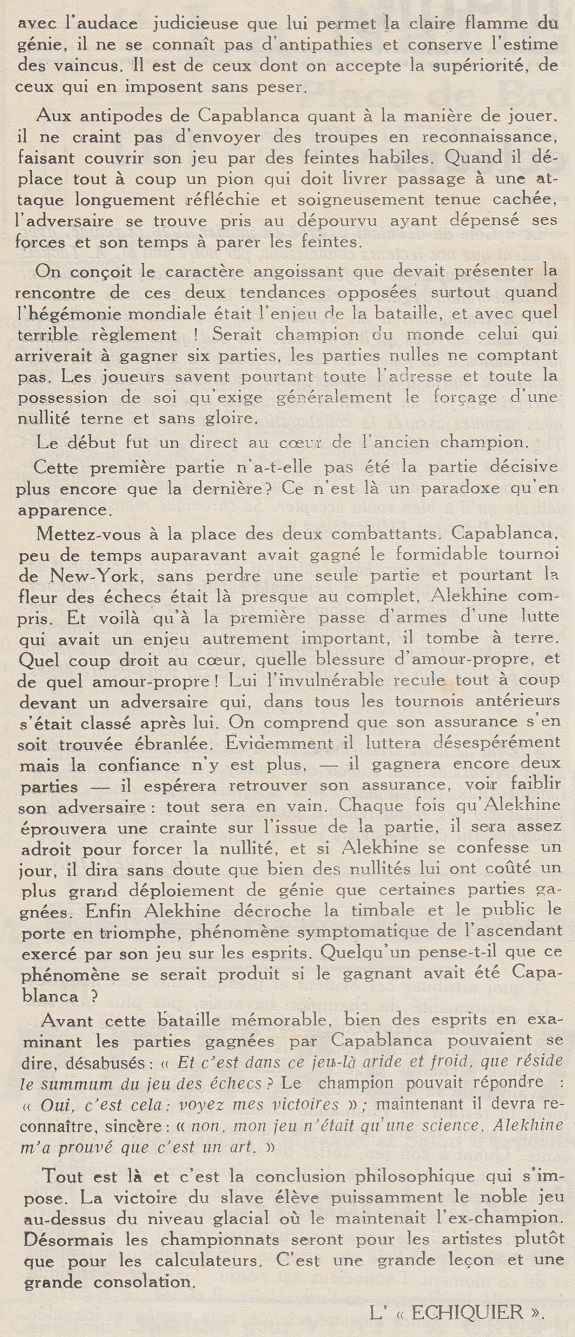
10811. Blackburne games
In 1991 Dale Brandreth published a scrapbook – presented to the Hampstead Chess Club by R.C. Griffith in 1918 – comprising chess columns (1891-94) in the Hampstead & Highgate Express, as well as other unidentified newspapers. Page 10 had three games from page 6 of the Hampstead & Highgate Express, 9 December 1893:
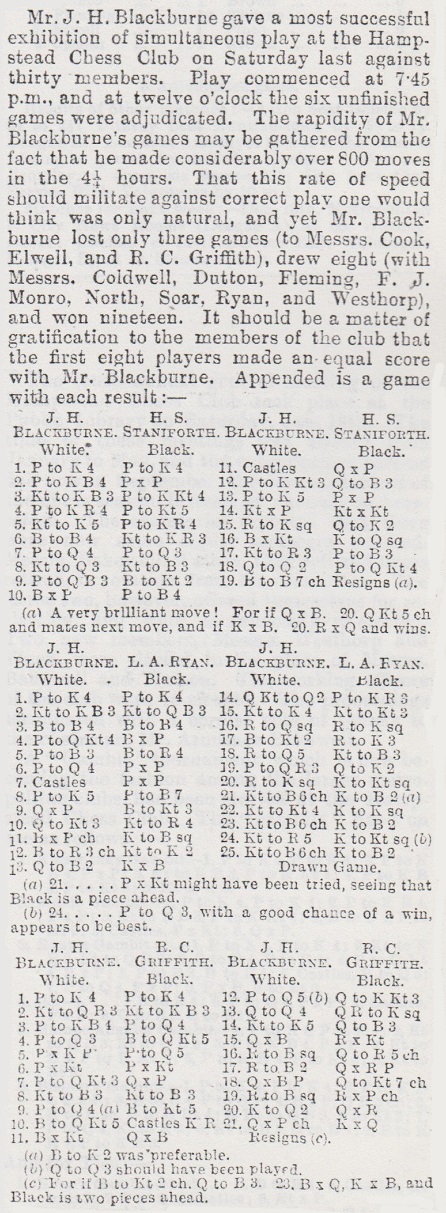
Joseph Henry Blackburne – H.S. Staniforth
Hampstead, 2 December 1893
King’s Gambit Accepted
1 e4 e5 2 f4 exf4 3 Nf3 g5 4 h4 g4 5 Ne5 h5 6 Bc4 Nh6 7 d4 d6 8 Nd3 Nc6 9 c3 Bg7 10 Bxf4 f5 11 O-O Qxh4 12 g3 Qf6 13 e5 dxe5 14 Nxe5 Nxe5 15 Re1 Qe7 16 Bxe5 Kd8 17 Na3 c6 18 Qd2 b5

19 Bc7+ Resigns.
Joseph Henry Blackburne – L.A. Ryan
Hampstead, 2 December 1893
Evans Gambit Accepted
1 e4 e5 2 Nf3 Nc6 3 Bc4 Bc5 4 b4 Bxb4 5 c3 Ba5 6 d4 exd4 7 O-O dxc3 8 e5 c2 9 Qxc2 Bb6 10 Qb3 Na5 11 Bxf7+ Kf8 12 Ba3+ Ne7 13 Qc2 Kxf7 14 Nbd2 h6 15 Ne4 Ng6 16 Rfd1 Re8 17 Bb2 Re6 18 Rd5 Nc6 19 a3 Qe7 20 Re1 Kg8
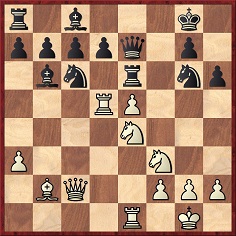
21 Nf6+ Kf7 22 Ng4 Ke8 23 Nf6+ Kf7 24 Nh5 Kg8 25 Nf6+ Kf7 Drawn.
Joseph Henry Blackburne – Richard Clewin Griffith
Hampstead, 2 December 1893
Vienna Gambit
1 e4 e5 2 Nc3 Nf6 3 f4 d5 4 d3 Bb4 5 fxe5 d4 6 exf6 dxc3 7 b3 Qxf6 8 Nf3 Nc6 9 d4 Bg4 10 Bb5 O-O 11 Bxc6 Qxc6 12 d5 Qg6 13 Qd4
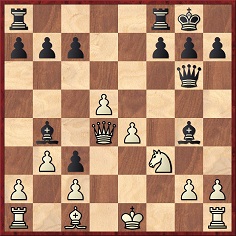
13...Rae8 14 Ne5 Qf6 15 Qxb4 Rxe5 16 Rf1 Qh4+ 17 Rf2 Qxh2 18 Qxc3 Qg1+ 19 Rf1 Rxe4+ 20 Kd2 Qxf1 21 Qxg7+ Kxg7 22 White resigns.
A game given sourcelessly on page 63 of the scrapbook:
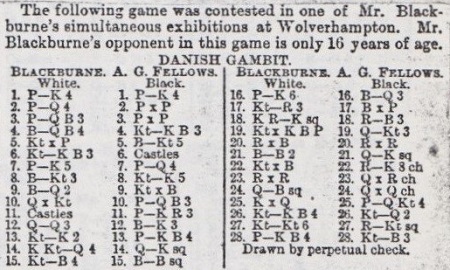
Morning Post, 26 November 1894, page 2
Joseph Henry Blackburne – Arthur G. Fellows
Wolverhampton (exact occasion and date?)
Danish Gambit
1 e4 e5 2 d4 exd4 3 c3 dxc3 4 Bc4 Nf6 5 Nxc3 Bb4 6 Nf3 O-O 7 e5 d5 8 Bb3 Ne4 9 Bd2 Nxd2 10 Qxd2 c6 11 O-O h6 12 Qd3 Be6 13 Ne2 f5 14 Nfd4 Qe8 15 Nf4 Bc8 16 e6 Bd6 17 Nh3 Bxe6 18 Rfe1 Rf6
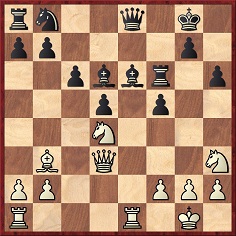
19 Nxf5 Qg6 20 Rxe6 Rxe6 21 Bc2 Qe8 22 Nxd6 Re1+ 23 Rxe1 Qxe1+ 24 Qf1 Qxf1+ 25 Kxf1 b5 26 Nf4 Nd7 27 Ng6 Rb8 28 f4 Nf6 Drawn.
Finally, page 81 of the scrapbook had this cutting from an unidentified source:
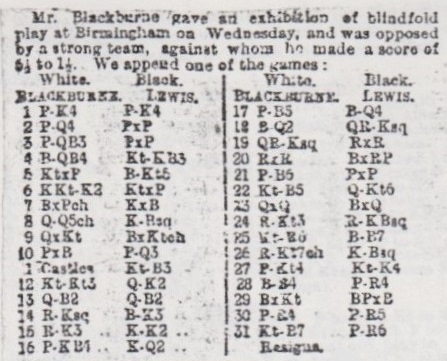
Joseph Henry Blackburne – C.F. Lewis
Birmingham, 18 October 1893
Danish Gambit
1 e4 e5 2 d4 exd4 3 c3 dxc3 4 Bc4 Nf6 5 Nxc3 Bb4 6 Ne2 Nxe4 7 Bxf7+ Kxf7 8 Qd5+ Kf8 9 Qxe4 Bxc3+ 10 bxc3 d6 11 O-O Nc6 12 Ng3 Qe7 13 Qc2 Qf7 14 Re1 Be6 15 Re3
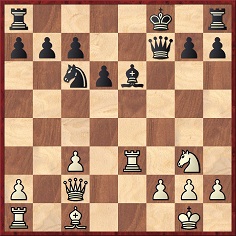
15...Ke7 16 f4 Kd7 17 f5 Bd5 18 Bd2 Rae8 19 Rae1 Rxe3 20 Rxe3 Bxa2 21 f6 gxf6 22 Nf5 Qb3 23 Qxb3 Bxb3 24 Rg3 Rf8 25 Nh6 Bc2 26 Rg7+ Kc8 27 g4 Ne5 28 Bf4 a5 29 Bxe5 fxe5 30 h4 a4 31 Nf7 a3 31 White resigns.
An account of Blackburne’s eight-board blindfold display in Birmingham was on page 5 of the Birmingham Daily Post, 19 October 1893:
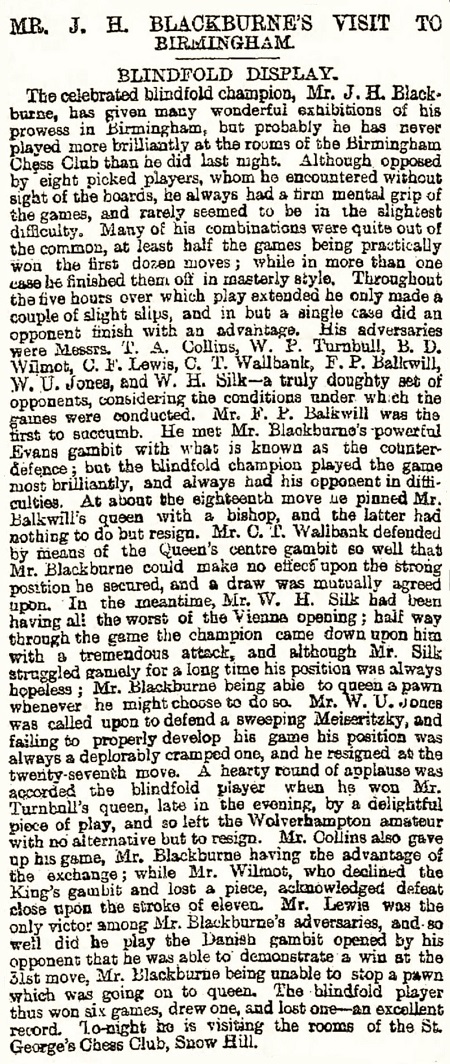
| First column | << previous | Archives [165] | next >> | Current column |
Copyright: Edward Winter. All rights reserved.

